A Research Project on the Challenges of Managing Global Teams
VerifiedAdded on 2023/06/12
|18
|3900
|218
Project
AI Summary
This research project proposal aims to investigate the challenges associated with managing global teams, a growing trend in today's interconnected business environment. The proposal includes a literature review summarizing existing research, identification of literature gaps, research questions, and hypotheses. It details both qualitative and quantitative research methodologies, including data collection methods, sampling strategies, and data analysis techniques. The proposal also addresses potential research limitations and provides a time schedule for the project. The study seeks to explore the impact of factors such as cultural diversity, physical distance, time differences, and language barriers on the coordination and management of global teams, aiming to provide insights beneficial to businesses and policymakers. Desklib provides a platform for students to access this and other solved assignments.

1
Challenges Managing Global Teams
Student name
Instructor
Course
Institution
Date
Challenges Managing Global Teams
Student name
Instructor
Course
Institution
Date
Paraphrase This Document
Need a fresh take? Get an instant paraphrase of this document with our AI Paraphraser
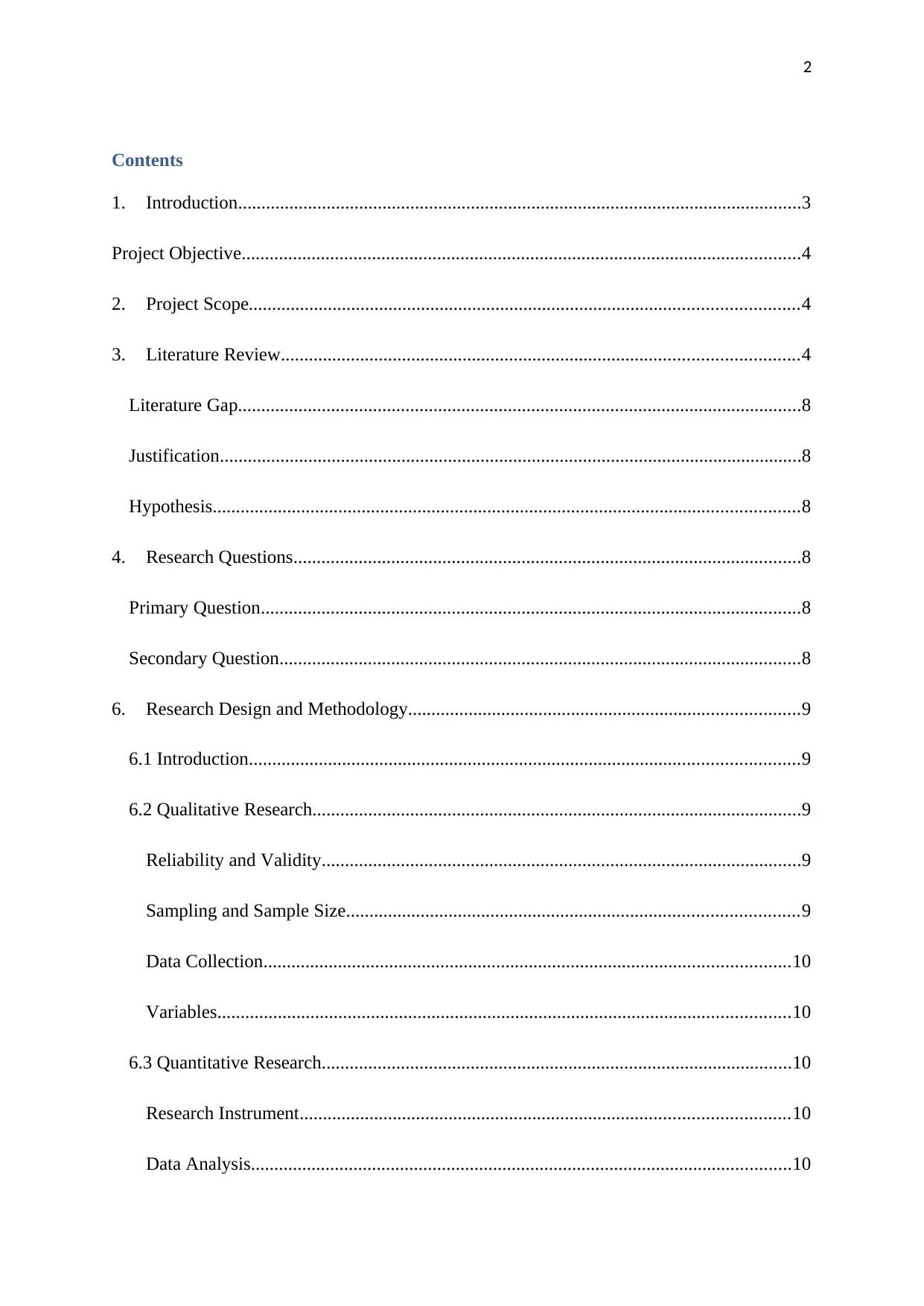
2
Contents
1. Introduction.........................................................................................................................3
Project Objective........................................................................................................................4
2. Project Scope......................................................................................................................4
3. Literature Review...............................................................................................................4
Literature Gap.........................................................................................................................8
Justification.............................................................................................................................8
Hypothesis..............................................................................................................................8
4. Research Questions.............................................................................................................8
Primary Question....................................................................................................................8
Secondary Question................................................................................................................8
6. Research Design and Methodology....................................................................................9
6.1 Introduction......................................................................................................................9
6.2 Qualitative Research.........................................................................................................9
Reliability and Validity.......................................................................................................9
Sampling and Sample Size.................................................................................................9
Data Collection.................................................................................................................10
Variables...........................................................................................................................10
6.3 Quantitative Research.....................................................................................................10
Research Instrument.........................................................................................................10
Data Analysis....................................................................................................................10
Contents
1. Introduction.........................................................................................................................3
Project Objective........................................................................................................................4
2. Project Scope......................................................................................................................4
3. Literature Review...............................................................................................................4
Literature Gap.........................................................................................................................8
Justification.............................................................................................................................8
Hypothesis..............................................................................................................................8
4. Research Questions.............................................................................................................8
Primary Question....................................................................................................................8
Secondary Question................................................................................................................8
6. Research Design and Methodology....................................................................................9
6.1 Introduction......................................................................................................................9
6.2 Qualitative Research.........................................................................................................9
Reliability and Validity.......................................................................................................9
Sampling and Sample Size.................................................................................................9
Data Collection.................................................................................................................10
Variables...........................................................................................................................10
6.3 Quantitative Research.....................................................................................................10
Research Instrument.........................................................................................................10
Data Analysis....................................................................................................................10
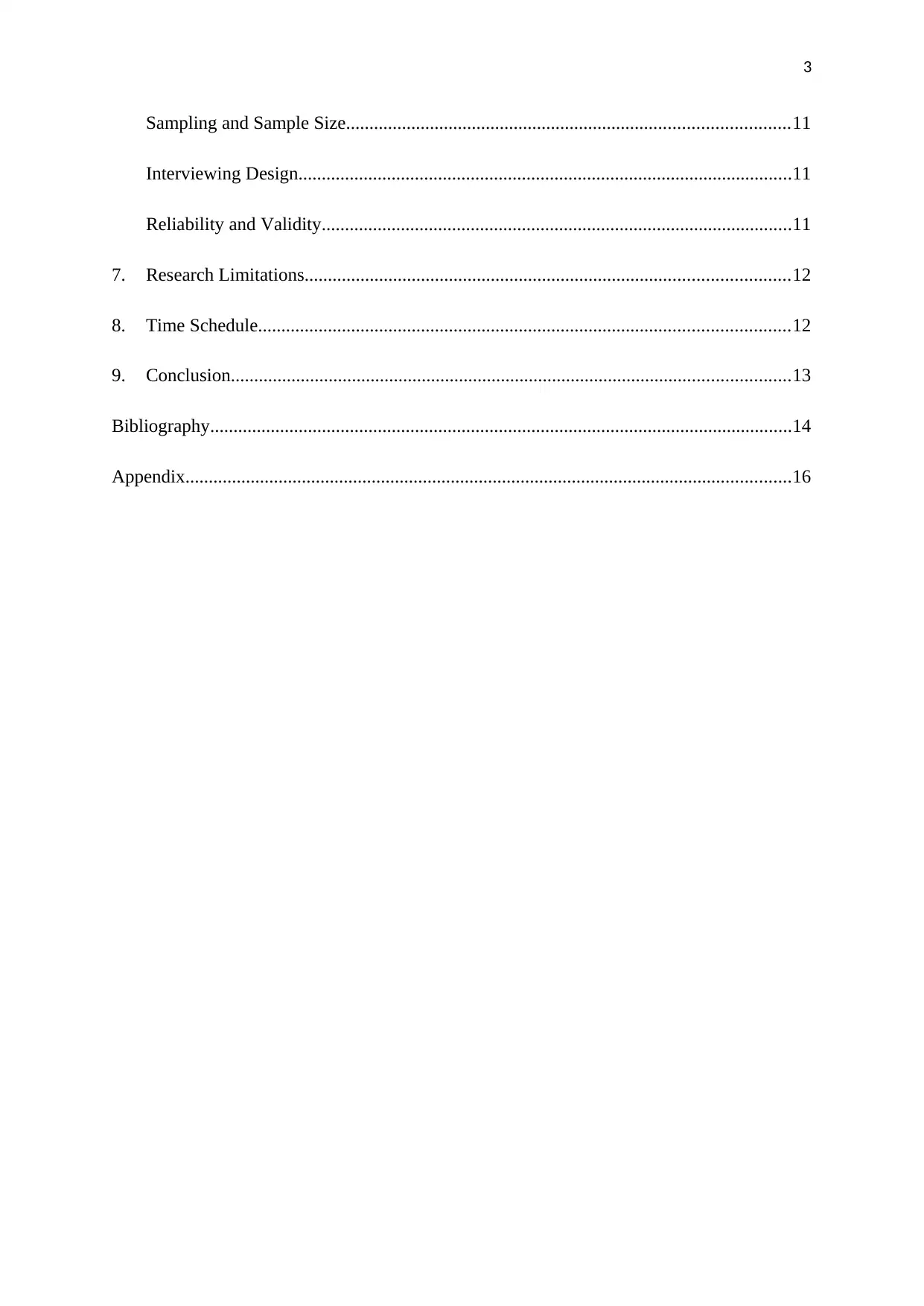
3
Sampling and Sample Size...............................................................................................11
Interviewing Design..........................................................................................................11
Reliability and Validity.....................................................................................................11
7. Research Limitations........................................................................................................12
8. Time Schedule..................................................................................................................12
9. Conclusion........................................................................................................................13
Bibliography.............................................................................................................................14
Appendix..................................................................................................................................16
Sampling and Sample Size...............................................................................................11
Interviewing Design..........................................................................................................11
Reliability and Validity.....................................................................................................11
7. Research Limitations........................................................................................................12
8. Time Schedule..................................................................................................................12
9. Conclusion........................................................................................................................13
Bibliography.............................................................................................................................14
Appendix..................................................................................................................................16
⊘ This is a preview!⊘
Do you want full access?
Subscribe today to unlock all pages.

Trusted by 1+ million students worldwide

4
1. Introduction
Technology and globalization have revolutionized trade, and now geographical
boundaries are no longer barriers to trade as businesses can trade comfortably with other
businesses and individuals over the internet. The growth of international trade has led to the
increase in the number of multinational enterprises, hence increasing the level of competition
between businesses. Technological developments have also led to the creation of virtual
companies operating online. Similarly, businesses with an offline presence are now having
online stores and are reaching out to customers and staff from other countries. At the same
time, the world of business has evolved, becoming very competitive because of the dynamic
changes taking place around the globe due to technological advancements (Pinjani, & Palvia,
2013)
The progression in innovation has given a stage to individuals, from various nations
around the globe, to impart and trade thoughts. Consequently, numerous organizations have
come to understand that the pool of occupation searchers around the globe can be more viable
and focused than the nearby pool of employment searchers. In this way, organizations have
swung to online networking and computerized stages to enlist profoundly talented and
aggressive specialists in their associations to accomplish an upper hand over different
organizations in their individual enterprises (Schuler, Jackson, & Tarique, 2011). Because of
the adjustment in the way of life of neighborhood procuring, organizations have specialists
from various nations and assorted societies being a piece of their workforce. These laborers
work remotely from the solace of their nations and are along these lines not anticipated that
they would migrate to the physical areas of the businesses hence are referred to as global
employees.
1. Introduction
Technology and globalization have revolutionized trade, and now geographical
boundaries are no longer barriers to trade as businesses can trade comfortably with other
businesses and individuals over the internet. The growth of international trade has led to the
increase in the number of multinational enterprises, hence increasing the level of competition
between businesses. Technological developments have also led to the creation of virtual
companies operating online. Similarly, businesses with an offline presence are now having
online stores and are reaching out to customers and staff from other countries. At the same
time, the world of business has evolved, becoming very competitive because of the dynamic
changes taking place around the globe due to technological advancements (Pinjani, & Palvia,
2013)
The progression in innovation has given a stage to individuals, from various nations
around the globe, to impart and trade thoughts. Consequently, numerous organizations have
come to understand that the pool of occupation searchers around the globe can be more viable
and focused than the nearby pool of employment searchers. In this way, organizations have
swung to online networking and computerized stages to enlist profoundly talented and
aggressive specialists in their associations to accomplish an upper hand over different
organizations in their individual enterprises (Schuler, Jackson, & Tarique, 2011). Because of
the adjustment in the way of life of neighborhood procuring, organizations have specialists
from various nations and assorted societies being a piece of their workforce. These laborers
work remotely from the solace of their nations and are along these lines not anticipated that
they would migrate to the physical areas of the businesses hence are referred to as global
employees.
Paraphrase This Document
Need a fresh take? Get an instant paraphrase of this document with our AI Paraphraser
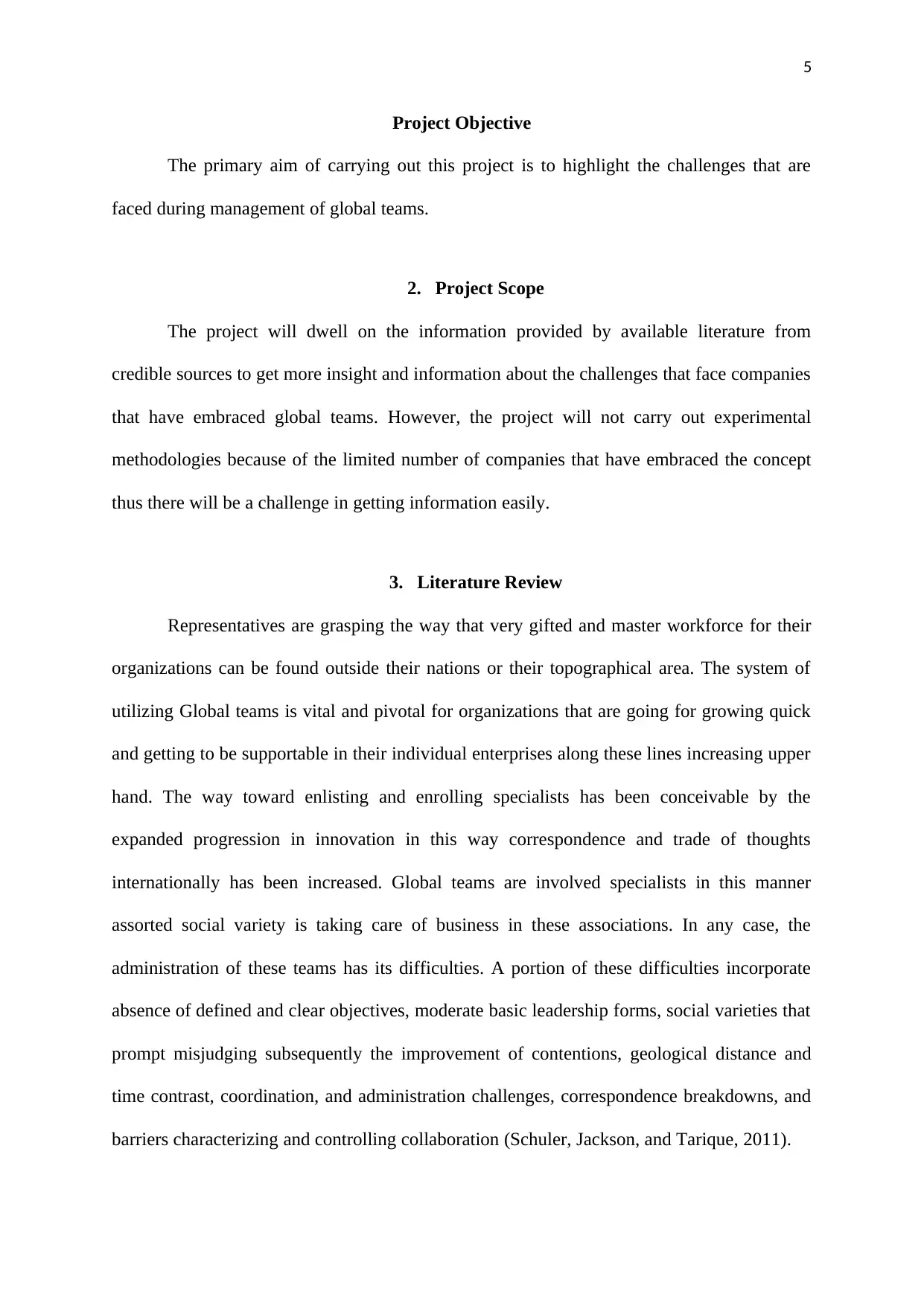
5
Project Objective
The primary aim of carrying out this project is to highlight the challenges that are
faced during management of global teams.
2. Project Scope
The project will dwell on the information provided by available literature from
credible sources to get more insight and information about the challenges that face companies
that have embraced global teams. However, the project will not carry out experimental
methodologies because of the limited number of companies that have embraced the concept
thus there will be a challenge in getting information easily.
3. Literature Review
Representatives are grasping the way that very gifted and master workforce for their
organizations can be found outside their nations or their topographical area. The system of
utilizing Global teams is vital and pivotal for organizations that are going for growing quick
and getting to be supportable in their individual enterprises along these lines increasing upper
hand. The way toward enlisting and enrolling specialists has been conceivable by the
expanded progression in innovation in this way correspondence and trade of thoughts
internationally has been increased. Global teams are involved specialists in this manner
assorted social variety is taking care of business in these associations. In any case, the
administration of these teams has its difficulties. A portion of these difficulties incorporate
absence of defined and clear objectives, moderate basic leadership forms, social varieties that
prompt misjudging subsequently the improvement of contentions, geological distance and
time contrast, coordination, and administration challenges, correspondence breakdowns, and
barriers characterizing and controlling collaboration (Schuler, Jackson, and Tarique, 2011).
Project Objective
The primary aim of carrying out this project is to highlight the challenges that are
faced during management of global teams.
2. Project Scope
The project will dwell on the information provided by available literature from
credible sources to get more insight and information about the challenges that face companies
that have embraced global teams. However, the project will not carry out experimental
methodologies because of the limited number of companies that have embraced the concept
thus there will be a challenge in getting information easily.
3. Literature Review
Representatives are grasping the way that very gifted and master workforce for their
organizations can be found outside their nations or their topographical area. The system of
utilizing Global teams is vital and pivotal for organizations that are going for growing quick
and getting to be supportable in their individual enterprises along these lines increasing upper
hand. The way toward enlisting and enrolling specialists has been conceivable by the
expanded progression in innovation in this way correspondence and trade of thoughts
internationally has been increased. Global teams are involved specialists in this manner
assorted social variety is taking care of business in these associations. In any case, the
administration of these teams has its difficulties. A portion of these difficulties incorporate
absence of defined and clear objectives, moderate basic leadership forms, social varieties that
prompt misjudging subsequently the improvement of contentions, geological distance and
time contrast, coordination, and administration challenges, correspondence breakdowns, and
barriers characterizing and controlling collaboration (Schuler, Jackson, and Tarique, 2011).
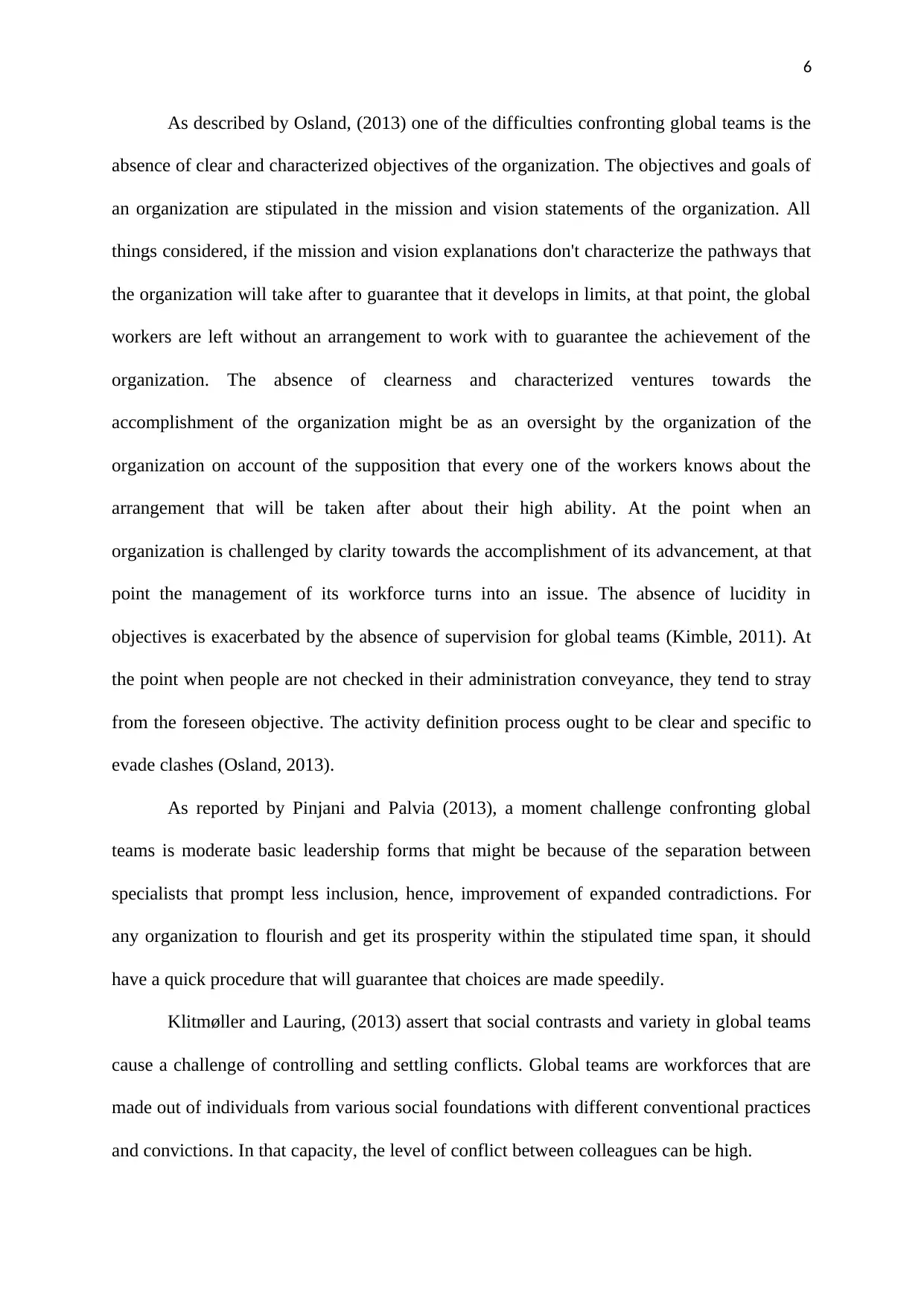
6
As described by Osland, (2013) one of the difficulties confronting global teams is the
absence of clear and characterized objectives of the organization. The objectives and goals of
an organization are stipulated in the mission and vision statements of the organization. All
things considered, if the mission and vision explanations don't characterize the pathways that
the organization will take after to guarantee that it develops in limits, at that point, the global
workers are left without an arrangement to work with to guarantee the achievement of the
organization. The absence of clearness and characterized ventures towards the
accomplishment of the organization might be as an oversight by the organization of the
organization on account of the supposition that every one of the workers knows about the
arrangement that will be taken after about their high ability. At the point when an
organization is challenged by clarity towards the accomplishment of its advancement, at that
point the management of its workforce turns into an issue. The absence of lucidity in
objectives is exacerbated by the absence of supervision for global teams (Kimble, 2011). At
the point when people are not checked in their administration conveyance, they tend to stray
from the foreseen objective. The activity definition process ought to be clear and specific to
evade clashes (Osland, 2013).
As reported by Pinjani and Palvia (2013), a moment challenge confronting global
teams is moderate basic leadership forms that might be because of the separation between
specialists that prompt less inclusion, hence, improvement of expanded contradictions. For
any organization to flourish and get its prosperity within the stipulated time span, it should
have a quick procedure that will guarantee that choices are made speedily.
Klitmøller and Lauring, (2013) assert that social contrasts and variety in global teams
cause a challenge of controlling and settling conflicts. Global teams are workforces that are
made out of individuals from various social foundations with different conventional practices
and convictions. In that capacity, the level of conflict between colleagues can be high.
As described by Osland, (2013) one of the difficulties confronting global teams is the
absence of clear and characterized objectives of the organization. The objectives and goals of
an organization are stipulated in the mission and vision statements of the organization. All
things considered, if the mission and vision explanations don't characterize the pathways that
the organization will take after to guarantee that it develops in limits, at that point, the global
workers are left without an arrangement to work with to guarantee the achievement of the
organization. The absence of clearness and characterized ventures towards the
accomplishment of the organization might be as an oversight by the organization of the
organization on account of the supposition that every one of the workers knows about the
arrangement that will be taken after about their high ability. At the point when an
organization is challenged by clarity towards the accomplishment of its advancement, at that
point the management of its workforce turns into an issue. The absence of lucidity in
objectives is exacerbated by the absence of supervision for global teams (Kimble, 2011). At
the point when people are not checked in their administration conveyance, they tend to stray
from the foreseen objective. The activity definition process ought to be clear and specific to
evade clashes (Osland, 2013).
As reported by Pinjani and Palvia (2013), a moment challenge confronting global
teams is moderate basic leadership forms that might be because of the separation between
specialists that prompt less inclusion, hence, improvement of expanded contradictions. For
any organization to flourish and get its prosperity within the stipulated time span, it should
have a quick procedure that will guarantee that choices are made speedily.
Klitmøller and Lauring, (2013) assert that social contrasts and variety in global teams
cause a challenge of controlling and settling conflicts. Global teams are workforces that are
made out of individuals from various social foundations with different conventional practices
and convictions. In that capacity, the level of conflict between colleagues can be high.
⊘ This is a preview!⊘
Do you want full access?
Subscribe today to unlock all pages.

Trusted by 1+ million students worldwide
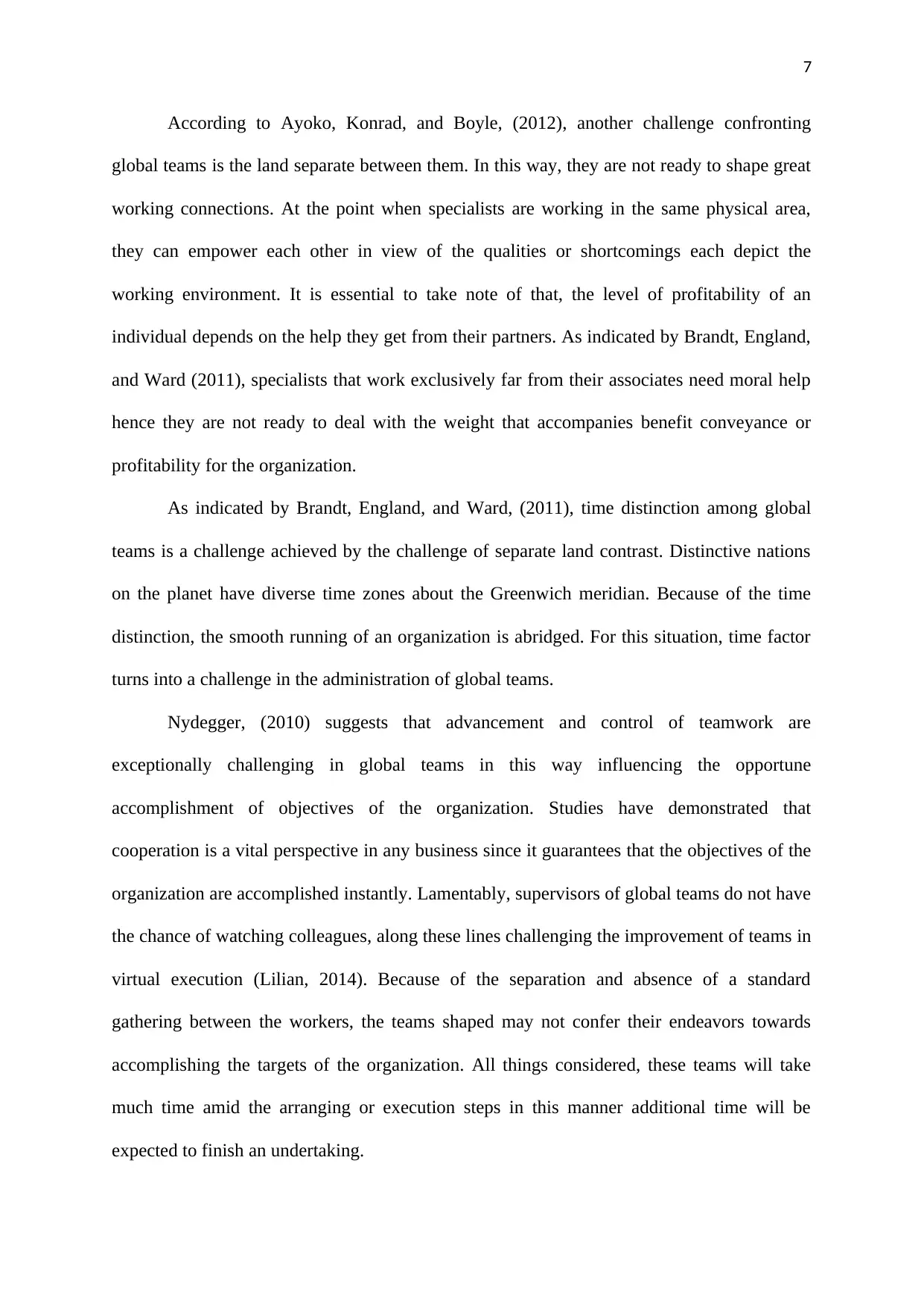
7
According to Ayoko, Konrad, and Boyle, (2012), another challenge confronting
global teams is the land separate between them. In this way, they are not ready to shape great
working connections. At the point when specialists are working in the same physical area,
they can empower each other in view of the qualities or shortcomings each depict the
working environment. It is essential to take note of that, the level of profitability of an
individual depends on the help they get from their partners. As indicated by Brandt, England,
and Ward (2011), specialists that work exclusively far from their associates need moral help
hence they are not ready to deal with the weight that accompanies benefit conveyance or
profitability for the organization.
As indicated by Brandt, England, and Ward, (2011), time distinction among global
teams is a challenge achieved by the challenge of separate land contrast. Distinctive nations
on the planet have diverse time zones about the Greenwich meridian. Because of the time
distinction, the smooth running of an organization is abridged. For this situation, time factor
turns into a challenge in the administration of global teams.
Nydegger, (2010) suggests that advancement and control of teamwork are
exceptionally challenging in global teams in this way influencing the opportune
accomplishment of objectives of the organization. Studies have demonstrated that
cooperation is a vital perspective in any business since it guarantees that the objectives of the
organization are accomplished instantly. Lamentably, supervisors of global teams do not have
the chance of watching colleagues, along these lines challenging the improvement of teams in
virtual execution (Lilian, 2014). Because of the separation and absence of a standard
gathering between the workers, the teams shaped may not confer their endeavors towards
accomplishing the targets of the organization. All things considered, these teams will take
much time amid the arranging or execution steps in this manner additional time will be
expected to finish an undertaking.
According to Ayoko, Konrad, and Boyle, (2012), another challenge confronting
global teams is the land separate between them. In this way, they are not ready to shape great
working connections. At the point when specialists are working in the same physical area,
they can empower each other in view of the qualities or shortcomings each depict the
working environment. It is essential to take note of that, the level of profitability of an
individual depends on the help they get from their partners. As indicated by Brandt, England,
and Ward (2011), specialists that work exclusively far from their associates need moral help
hence they are not ready to deal with the weight that accompanies benefit conveyance or
profitability for the organization.
As indicated by Brandt, England, and Ward, (2011), time distinction among global
teams is a challenge achieved by the challenge of separate land contrast. Distinctive nations
on the planet have diverse time zones about the Greenwich meridian. Because of the time
distinction, the smooth running of an organization is abridged. For this situation, time factor
turns into a challenge in the administration of global teams.
Nydegger, (2010) suggests that advancement and control of teamwork are
exceptionally challenging in global teams in this way influencing the opportune
accomplishment of objectives of the organization. Studies have demonstrated that
cooperation is a vital perspective in any business since it guarantees that the objectives of the
organization are accomplished instantly. Lamentably, supervisors of global teams do not have
the chance of watching colleagues, along these lines challenging the improvement of teams in
virtual execution (Lilian, 2014). Because of the separation and absence of a standard
gathering between the workers, the teams shaped may not confer their endeavors towards
accomplishing the targets of the organization. All things considered, these teams will take
much time amid the arranging or execution steps in this manner additional time will be
expected to finish an undertaking.
Paraphrase This Document
Need a fresh take? Get an instant paraphrase of this document with our AI Paraphraser
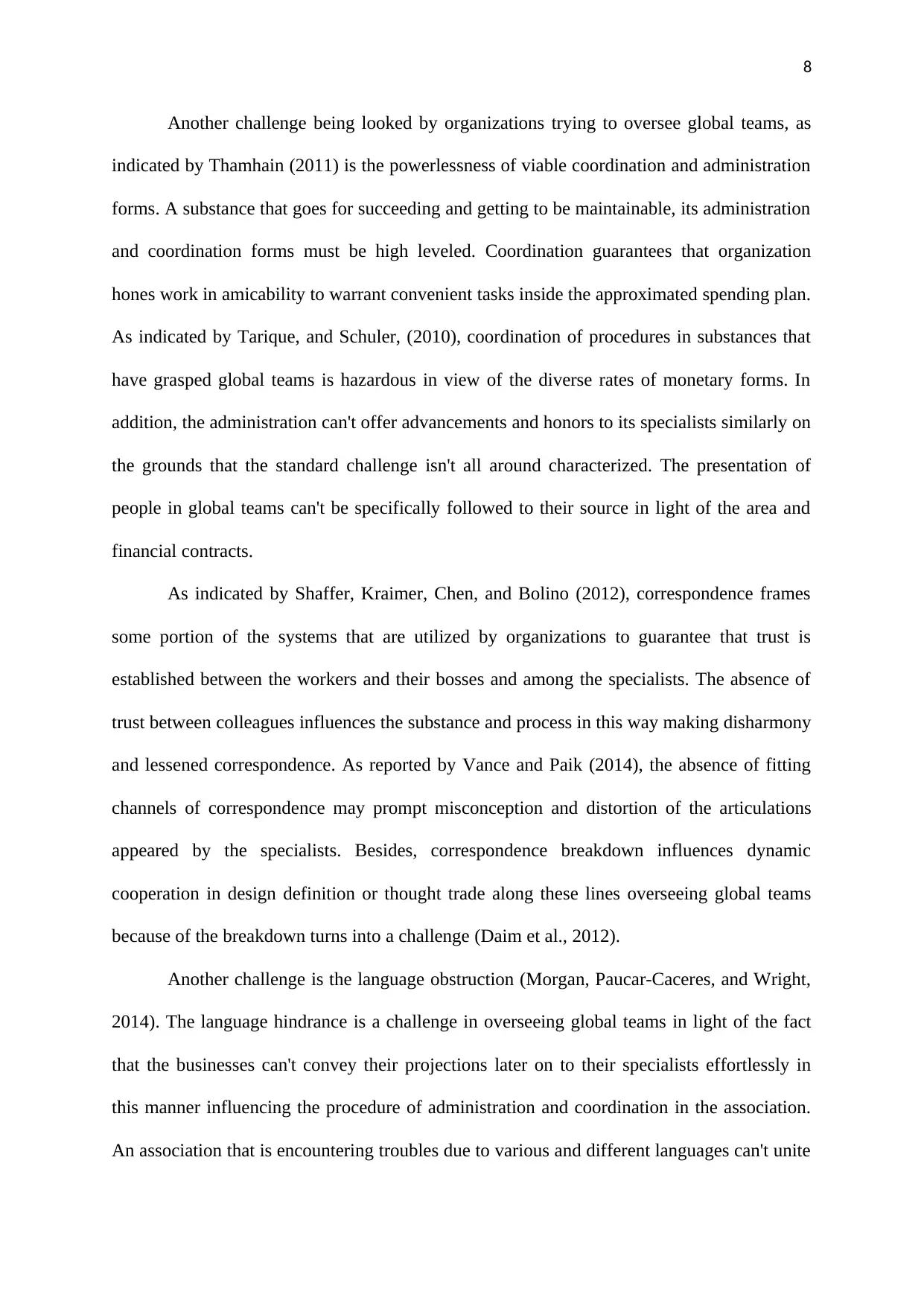
8
Another challenge being looked by organizations trying to oversee global teams, as
indicated by Thamhain (2011) is the powerlessness of viable coordination and administration
forms. A substance that goes for succeeding and getting to be maintainable, its administration
and coordination forms must be high leveled. Coordination guarantees that organization
hones work in amicability to warrant convenient tasks inside the approximated spending plan.
As indicated by Tarique, and Schuler, (2010), coordination of procedures in substances that
have grasped global teams is hazardous in view of the diverse rates of monetary forms. In
addition, the administration can't offer advancements and honors to its specialists similarly on
the grounds that the standard challenge isn't all around characterized. The presentation of
people in global teams can't be specifically followed to their source in light of the area and
financial contracts.
As indicated by Shaffer, Kraimer, Chen, and Bolino (2012), correspondence frames
some portion of the systems that are utilized by organizations to guarantee that trust is
established between the workers and their bosses and among the specialists. The absence of
trust between colleagues influences the substance and process in this way making disharmony
and lessened correspondence. As reported by Vance and Paik (2014), the absence of fitting
channels of correspondence may prompt misconception and distortion of the articulations
appeared by the specialists. Besides, correspondence breakdown influences dynamic
cooperation in design definition or thought trade along these lines overseeing global teams
because of the breakdown turns into a challenge (Daim et al., 2012).
Another challenge is the language obstruction (Morgan, Paucar-Caceres, and Wright,
2014). The language hindrance is a challenge in overseeing global teams in light of the fact
that the businesses can't convey their projections later on to their specialists effortlessly in
this manner influencing the procedure of administration and coordination in the association.
An association that is encountering troubles due to various and different languages can't unite
Another challenge being looked by organizations trying to oversee global teams, as
indicated by Thamhain (2011) is the powerlessness of viable coordination and administration
forms. A substance that goes for succeeding and getting to be maintainable, its administration
and coordination forms must be high leveled. Coordination guarantees that organization
hones work in amicability to warrant convenient tasks inside the approximated spending plan.
As indicated by Tarique, and Schuler, (2010), coordination of procedures in substances that
have grasped global teams is hazardous in view of the diverse rates of monetary forms. In
addition, the administration can't offer advancements and honors to its specialists similarly on
the grounds that the standard challenge isn't all around characterized. The presentation of
people in global teams can't be specifically followed to their source in light of the area and
financial contracts.
As indicated by Shaffer, Kraimer, Chen, and Bolino (2012), correspondence frames
some portion of the systems that are utilized by organizations to guarantee that trust is
established between the workers and their bosses and among the specialists. The absence of
trust between colleagues influences the substance and process in this way making disharmony
and lessened correspondence. As reported by Vance and Paik (2014), the absence of fitting
channels of correspondence may prompt misconception and distortion of the articulations
appeared by the specialists. Besides, correspondence breakdown influences dynamic
cooperation in design definition or thought trade along these lines overseeing global teams
because of the breakdown turns into a challenge (Daim et al., 2012).
Another challenge is the language obstruction (Morgan, Paucar-Caceres, and Wright,
2014). The language hindrance is a challenge in overseeing global teams in light of the fact
that the businesses can't convey their projections later on to their specialists effortlessly in
this manner influencing the procedure of administration and coordination in the association.
An association that is encountering troubles due to various and different languages can't unite

9
specialists in this manner they can't work in agreement. Consequently, its execution is
significantly influenced, and its prosperity is compromised.
Literature Gap
Globalizations and global teams are relatively new trends and are powered by the
internet. Because of this, few researchers have successfully studied global teams and how
businesses manage their remote employees working in foreign countries far from the physical
location of the organization. This paper proposes to conduct a research project to address the
challenges faced by managers of global teams in a bid to fill the gap in research.
Justification
Filling the gap in research will be beneficial to businesses and individual researchers
who are interested in related topics. Governments and other policymakers may also find this
paper t be relevant in firming their debate.
Hypothesis
Null hypothesis: There are not challenges in managing global teams
4. Research Questions
Primary Question
1. What are the challenges that are faced during management of global teams?
Secondary Question
1. How do company goals affect the coordination of global teams?
2. What are the implications of cultural diversity in global teams?
3. What is the impact of physical distance on the management of global teams?
4. How does the time difference impact the management of global teams?
5. How does language barrier affect communication in managing global teams?
specialists in this manner they can't work in agreement. Consequently, its execution is
significantly influenced, and its prosperity is compromised.
Literature Gap
Globalizations and global teams are relatively new trends and are powered by the
internet. Because of this, few researchers have successfully studied global teams and how
businesses manage their remote employees working in foreign countries far from the physical
location of the organization. This paper proposes to conduct a research project to address the
challenges faced by managers of global teams in a bid to fill the gap in research.
Justification
Filling the gap in research will be beneficial to businesses and individual researchers
who are interested in related topics. Governments and other policymakers may also find this
paper t be relevant in firming their debate.
Hypothesis
Null hypothesis: There are not challenges in managing global teams
4. Research Questions
Primary Question
1. What are the challenges that are faced during management of global teams?
Secondary Question
1. How do company goals affect the coordination of global teams?
2. What are the implications of cultural diversity in global teams?
3. What is the impact of physical distance on the management of global teams?
4. How does the time difference impact the management of global teams?
5. How does language barrier affect communication in managing global teams?
⊘ This is a preview!⊘
Do you want full access?
Subscribe today to unlock all pages.

Trusted by 1+ million students worldwide

10
6. Research Design and Methodology
6.1 Introduction
The methodology of the study is guided by Mark Saunders’ “research onion.” Bryman
and Bell (2015) indicate that the research design is the plan of the study. The current research
will use the positivism philosophy to derive information about the challenges of managing
global teams. Further, a deductive approach will be employed in explaining the relationship
between global teams and management challenges (Saunders et al., 2015). The research will
employ a survey design to collect and analyze both quantitative and qualitative data. This
method will be helpful in answering the research question and challenging the research
hypotheses.
6.2 Qualitative Research
Qualitative research will take place in two forms: during the collection of secondary
data, and during the collection of primary data. During the secondary data collection,
keywords and keyword combinations into relevant phrases will be used to identify relevant
published literature in online databases and the university library.
Reliability and Validity
There will be no challenge for reliability and validity since secondary data collection
and observations are not necessarily challenged.
Sampling and Sample Size
The researcher will select 16 of the most relevant sources after a search of the
keywords in the respective databases. The sources of data will be selected based on their
relevance to the study. The researcher will develop an annotated bibliography of the
6. Research Design and Methodology
6.1 Introduction
The methodology of the study is guided by Mark Saunders’ “research onion.” Bryman
and Bell (2015) indicate that the research design is the plan of the study. The current research
will use the positivism philosophy to derive information about the challenges of managing
global teams. Further, a deductive approach will be employed in explaining the relationship
between global teams and management challenges (Saunders et al., 2015). The research will
employ a survey design to collect and analyze both quantitative and qualitative data. This
method will be helpful in answering the research question and challenging the research
hypotheses.
6.2 Qualitative Research
Qualitative research will take place in two forms: during the collection of secondary
data, and during the collection of primary data. During the secondary data collection,
keywords and keyword combinations into relevant phrases will be used to identify relevant
published literature in online databases and the university library.
Reliability and Validity
There will be no challenge for reliability and validity since secondary data collection
and observations are not necessarily challenged.
Sampling and Sample Size
The researcher will select 16 of the most relevant sources after a search of the
keywords in the respective databases. The sources of data will be selected based on their
relevance to the study. The researcher will develop an annotated bibliography of the
Paraphrase This Document
Need a fresh take? Get an instant paraphrase of this document with our AI Paraphraser

11
materials to be used in the collection of data following the keywords search. The keywords
will include challenges, global teams, and management searched in several combinations.
During the primary data collection, observations will be used to collect ordinal data.
Data Collection
Data will be collected from the annotated bibliography and recorded in notes for
analysis and interpretation.
Variables
Two variables will be studied, challenges and global teams.
6.3 Quantitative Research
Quantitative research will be vital in deriving statistical information from the
participants to determine the extent of the challenges faced by managers of global teams
(Bryman & Bell, 2015).
Research Instrument
Data collection refers to the tools and procedures to be used in collecting data
(Saunders et al., 2015). In this study, face-to-face interviews will be conducted to gather
relevant information from the participating managers. Face-to-face interviews allow the
researcher to collect data through observation.
Data Analysis
Peck and his colleagues indicate that data analysis evaluates the data collected for
deductions and inference (2015). Qualitative data will be analyzed using content analysis to
determine emerging themes while and descriptive statistics will be used to describe the
materials to be used in the collection of data following the keywords search. The keywords
will include challenges, global teams, and management searched in several combinations.
During the primary data collection, observations will be used to collect ordinal data.
Data Collection
Data will be collected from the annotated bibliography and recorded in notes for
analysis and interpretation.
Variables
Two variables will be studied, challenges and global teams.
6.3 Quantitative Research
Quantitative research will be vital in deriving statistical information from the
participants to determine the extent of the challenges faced by managers of global teams
(Bryman & Bell, 2015).
Research Instrument
Data collection refers to the tools and procedures to be used in collecting data
(Saunders et al., 2015). In this study, face-to-face interviews will be conducted to gather
relevant information from the participating managers. Face-to-face interviews allow the
researcher to collect data through observation.
Data Analysis
Peck and his colleagues indicate that data analysis evaluates the data collected for
deductions and inference (2015). Qualitative data will be analyzed using content analysis to
determine emerging themes while and descriptive statistics will be used to describe the

12
statistical findings. Data from the audio recordings will be transcribed verbatim, and the
results will be coded to determine themes. After coding the information will be presented in
tables and graphs for ease of interpretation.
Sampling and Sample Size
Sampling is the selection of representatives from the research population (Peck,
Olsen, & Devore, 2015). The purposive sampling technique will be used to select the
population sample based on merit. Purposive sampling is a non-probability sampling
technique used to determine the participants in a research project. Therefore, the researcher
will selectively choose the research participants based on their accessibility and convenient
proximity.
The sample size refers to the number of individuals participating in the study. Bryman
and Bell (2015) assert that large sample size would be efficient in data collection and
suggests that good sample size should include between 10% and 30% of the population under
study. The research will use a heterogeneous sample that includes both male and female
genders irrespective of one’s background. Consequently, the project will sample up to 15
senior and junior managers from five multinational companies that employ global teams.
Interviewing Design
Each interview is expected to use up to forty-five minutes depending on the depth of
the questions and details collected. The researcher will focus on one firm at a time. In each
firm at least one senior and one junior manager will be interviewed.
Reliability and Validity
Interviews are authentic and are considered to be trustworthy as long as the questions
are reliable and valid. As such, it is not necessary to challenge for reliability and validity of
statistical findings. Data from the audio recordings will be transcribed verbatim, and the
results will be coded to determine themes. After coding the information will be presented in
tables and graphs for ease of interpretation.
Sampling and Sample Size
Sampling is the selection of representatives from the research population (Peck,
Olsen, & Devore, 2015). The purposive sampling technique will be used to select the
population sample based on merit. Purposive sampling is a non-probability sampling
technique used to determine the participants in a research project. Therefore, the researcher
will selectively choose the research participants based on their accessibility and convenient
proximity.
The sample size refers to the number of individuals participating in the study. Bryman
and Bell (2015) assert that large sample size would be efficient in data collection and
suggests that good sample size should include between 10% and 30% of the population under
study. The research will use a heterogeneous sample that includes both male and female
genders irrespective of one’s background. Consequently, the project will sample up to 15
senior and junior managers from five multinational companies that employ global teams.
Interviewing Design
Each interview is expected to use up to forty-five minutes depending on the depth of
the questions and details collected. The researcher will focus on one firm at a time. In each
firm at least one senior and one junior manager will be interviewed.
Reliability and Validity
Interviews are authentic and are considered to be trustworthy as long as the questions
are reliable and valid. As such, it is not necessary to challenge for reliability and validity of
⊘ This is a preview!⊘
Do you want full access?
Subscribe today to unlock all pages.

Trusted by 1+ million students worldwide
1 out of 18
Related Documents
Your All-in-One AI-Powered Toolkit for Academic Success.
+13062052269
info@desklib.com
Available 24*7 on WhatsApp / Email
![[object Object]](/_next/static/media/star-bottom.7253800d.svg)
Unlock your academic potential
Copyright © 2020–2025 A2Z Services. All Rights Reserved. Developed and managed by ZUCOL.





